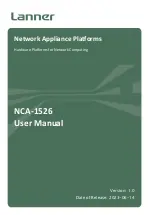
AT-GS950/16PS Switch Web Interface User’s Guide
365
VLANs Across Different Regions
Special consideration needs to be taken into account when you connect
different MSTP regions or an MSTP region and a single-instance STP or
RSTP region. Unless planned properly, VLAN fragmentation can occur
between the VLANS of your network.
As mentioned previously, only the CIST can span regions. A MSTI cannot.
Consequently, you may run into a problem if you use more than one physical
data link to connect together various parts of VLANs that reside in bridges in
different regions. The result can be a physical loop, which spanning tree
disables by blocking ports.
This is illustrated in Figure 144. The example show two switches, each
residing in a different region. Port 7 in switch A is a boundary port. It is an
untagged member of the Accounting VLAN, which has been associated with
MSTI 4. Port 6 is a tagged and untagged member of two different VLANs, both
associated to MSTI 12.
If both switches were a part of the same region, there would be no problem
because the ports reside in different spanning tree instances. However in this
example, the switches are part of different regions and MSTIs do not cross
regions. Consequently, the result is that spanning tree would determine that a
loop exists between the regions, Switch B would block a port and the
Accounting VLAN would be disabled between the two regions.
Figure 144. Spanning Regions - Example 1
There are several ways to address this issue. One is to configure only one
MSTP region for each subnet in your network. This will eliminate the potential
situation of a loop and blocked port(s) between multiple regions.
Another approach is to configure multiple regions in a subnet and group the
VLANs that need to span two or more regions into the same MSTI. If other
VLANs also exist that do not span multiple regions, they can be assigned to
other MSTIs within their respective region.
Here is an example. Assume that you have two regions that contain the
following VLANS:
Содержание AT-GS950/16PS
Страница 12: ...Figures 12...
Страница 14: ...List of Tables 14...
Страница 18: ...Preface 18...
Страница 20: ...20...
Страница 52: ...Chapter 2 System Configuration 52...
Страница 54: ...54...
Страница 92: ...Chapter 5 Multiple Spanning Tree Protocol 92...
Страница 102: ...Chapter 6 Static Port Trunking 102...
Страница 118: ...Chapter 8 Port Mirroring 118...
Страница 140: ...Chapter 11 IGMP Snooping 140...
Страница 174: ...Chapter 14 GVRP 174...
Страница 186: ...Chapter 15 Quality of Service and Cost of Service 186...
Страница 188: ...188...
Страница 216: ...Chapter 17 SNMPv3 216...
Страница 244: ...Chapter 18 Access Control Configuration 244...
Страница 282: ...Chapter 21 Security 282...
Страница 288: ...Chapter 22 Power Over Ethernet PoE 288...
Страница 289: ...289 Chapter 23...
Страница 310: ...Chapter 24 LLDP 310...
Страница 322: ...322...
Страница 334: ...Chapter 26 Software Configuration Updates 334...
Страница 346: ...Chapter 28 Rebooting the AT GS950 16PS 346...
Страница 368: ...Appendix A MSTP Overview 368...
Страница 386: ...Appendix B AT GS950 16PS Default Parameters 386...
















































